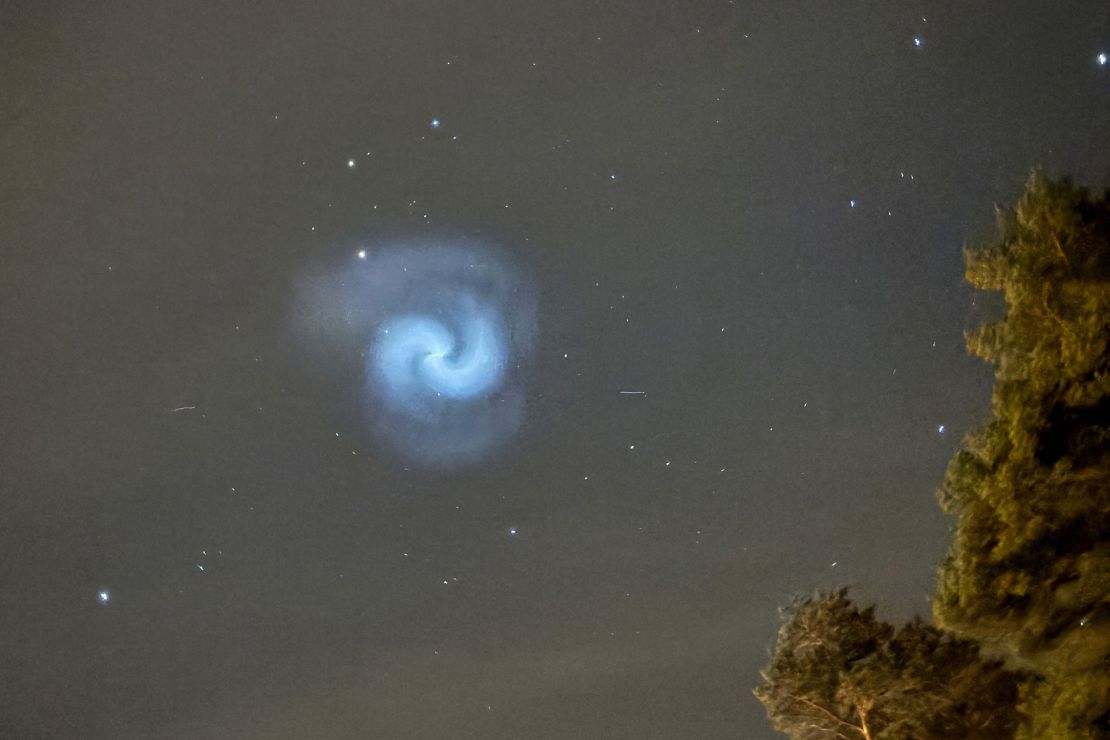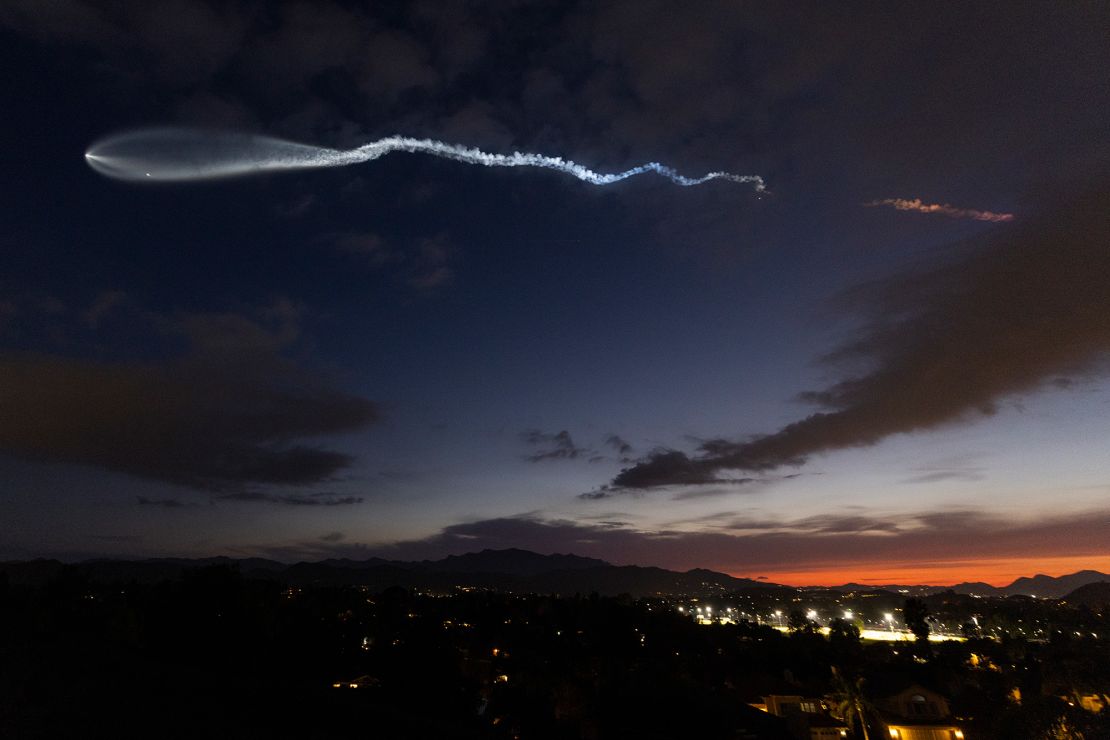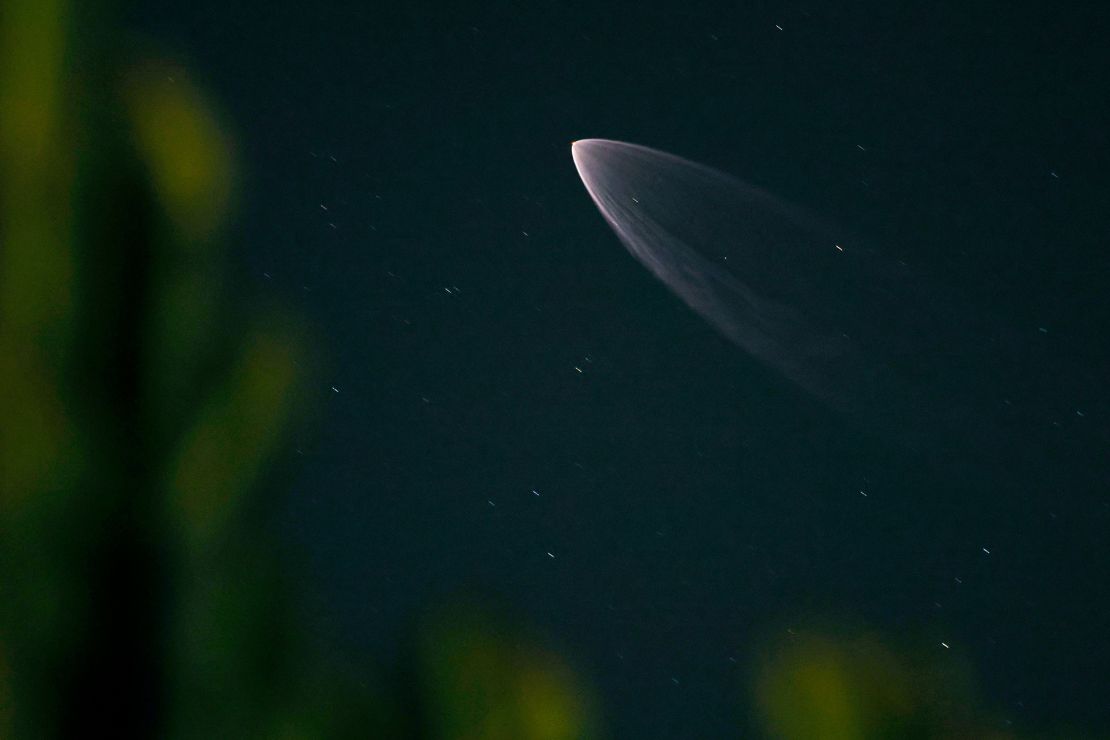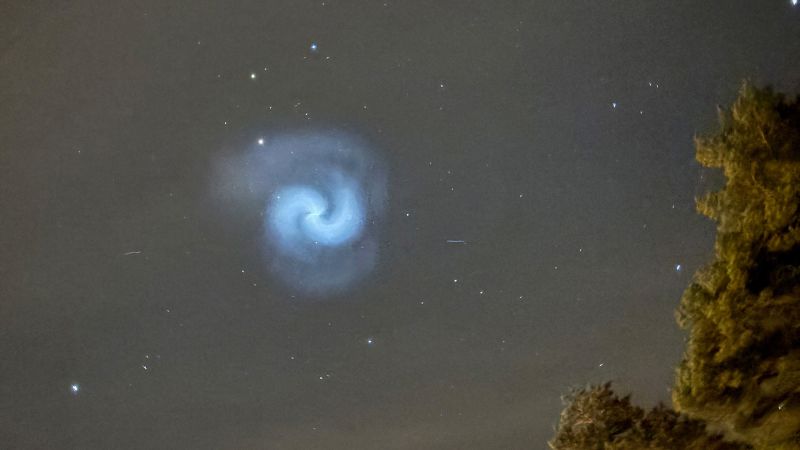Sign up for CNN’s Wonder Theory science newsletter. Explore the universe with news on fascinating discoveries, scientific advancements and more.
CNN
—
The shapes can seem to appear out of nowhere: an undulating S-like spiral streaking across the European skies or a glowing orb trailing above the North American coast.
Such strange light shows have been a known feature of rocket launches for years. But as humanity rapidly increases the number of objects propelled into space — more people are inadvertently witnessing the phenomena.
“We’re not used to seeing things that are happening in space in these very low (atmospheric) densities,” said Jonathan McDowell, an astrophysicist and astronomer at the Harvard-Smithsonian Center for Astrophysics, referring to the thin atmosphere that exists at high altitudes and in Earth’s orbit.
When a SpaceX Falcon 9 rocket took off from Florida last week — flying northeastward as it headed for Earth’s orbit to drop off a spy satellite for the US military — it put on a show for millions over the United Kingdom and the European continent.
Shortly after launch, social media users began to report “strange shapes” dancing in the sky.
The scene was “likely to be caused by the SpaceX Falcon 9 rocket,” according to a post on X that the Met Office, Britain’s national weather service, shared after the launch.
The viral images were reminiscent of the “jellyfish” phenomenon that has accompanied some SpaceX launches from Florida and California. Visible from the North American coasts, the “jellyfish” is marked by a massive teardrop-shaped streak of light that grows and stretches as the rocket flies.
Despite their similarities, however, experts said the phenomena of the jellyfish and spiral are distinct.
The eerie bat signal-like spiral following SpaceX’s March 24 military satellite launch formed after the rocket had already made its delivery. The vehicle was preparing to plunge out of orbit and back into Earth’s atmosphere, twirling toward a safe splashdown in the ocean — and leaving fuel in its wake.
Such maneuvers made to dispose of rocket bodies are common after launches.
The Falcon 9 is designed to break into two parts — or “stages.”
The first stage is the bottommost portion of the rocket with nine engines that fire up at liftoff, powering the 230-foot (70-meter) vehicle off the ground. The first-stage booster is also the same part that SpaceX routinely guides to landing after launch and reuses to save money.
The second, or upper, stage of the rocket, however, is designed to fire up its own engine.
The second stage gives the last burst of power that drives the rocket’s cargo — whether a satellite or an astronaut capsule — to the speeds required to enter orbit around Earth. That’s typically more than 17,500 miles per hour (28,163 kilometers per hour).

But after the March 24 trip to orbit, the SpaceX Falcon 9 second stage still had fuel left on board that it needed to unload.
“Dumping the leftover fuel is basically a safety precaution and often preparing (the rocket’s second stage) for deorbit and to return it into the ocean,” said Dr. Christopher Combs, associate dean for research at the Klesse College of Engineering and Integrated Design at the University of Texas at San Antonio.
So, the upper stage of the Falcon 9 rocket begins spinning, flinging its fuel into space as it continues moving, creating the swelling spiral shape in the sky.
It’s a phenomenon McDowell described as a “garden hose effect” — reminiscent of when a hose in a yard is turned on and begins to wriggle and wave as its sprays.
The jellyfish phenomenon that is often spotted from the Americas after SpaceX launches is “a similar, but actually distinctly different phenomenon,” Combs said.
That spectacle is caused by an exhaust plume that emanates from the Falcon 9 rocket’s first stage during its ascent as the rocket and its cargo are still heading toward their drop-off point in orbit, McDowell explained.
The jellyfish shape is the result of the rocket’s exhaust plume growing and fanning out as it burns.

It looks far different from how the exhaust appears closer to the ground: When the rocket first begins firing off a launchpad, the discharge bursts out in a narrow trail. But when the vehicle starts burning in the upper atmosphere, there’s less air for the exhaust to bump up against — so it doesn’t stay confined to a contrail.
Instead, “you get this big bubble,” that grows and expands, creating the jellyfish effect, McDowell said.
Both the jellyfish and the spiral require specific lighting conditions to be visible to human eyes. A viewer must be standing in darkness while the rocket is high up, catching glints of sunshine beyond the horizon.
“It tends to be early evening or dawn, not the middle of the night,” when the phenomena appear, McDowell said.
And, McDowell noted, the light shows can trick our brains into thinking the rockets are closer to the ground than they actually are.

“We’re so used to seeing airplanes, subconsciously, when we see this thing in the sky; we’re thinking that it’s not that much higher than an airplane,” McDowell said of the spiral phenomenon. Onlookers may think the rocket is “maybe 10 or 20 miles up, when it’s really 200 miles up.”
Catching a glimpse of a rocket-related light show can be tough since it requires precise timing and a bit of luck.
But the number of launches has already increased rapidly — rising from a peak of less than 150 per year in the 20th century to more than 250 last year, according to statistics McDowell has compiled.
And Combs said he hopes audiences will continue to be drawn in by the strange light shows the rockets produce.
“I love it when people are taking an interest in space,” he said. “I encourage folks to keep asking questions.”

